Learning guitar is an exciting journey, and mastering Guitar Chords Basic is one of the first, yet most crucial steps. Many aspiring guitarists are eager to dive into playing songs but might feel intimidated by the idea of understanding guitar chord theory. Perhaps you’re someone who, like many, initially focused solely on lead guitar, neglecting the foundational power of chords. However, grasping the basics of how guitar chords are constructed and function can profoundly enhance your overall playing, opening up new musical possibilities.
For years, neglecting chords might seem like a viable path, especially when drawn to the flash of lead guitarists. Hours could be spent learning solos, yet basic chords might remain a mystery. However, dedicating time to learn guitar chords basic theory can bridge this gap, transforming your playing in unexpected ways.
Developing a solid understanding of guitar chords and their underlying theory has significant benefits. Firstly, it drastically improves your rhythm guitar skills, allowing you to confidently play along with songs and create your own accompaniments. Secondly, and perhaps surprisingly, it elevates your lead guitar playing. Solos are almost always played over chord progressions, and knowing how chords are built allows you to craft more melodic, sophisticated, and contextually fitting solos. Instead of simply playing “on top” of a backing track, you’ll be playing with it.
Furthermore, if songwriting is your ambition, learning guitar chords basic theory is indispensable. It empowers you to create interesting and emotionally resonant chord progressions, forming the backbone of your original music.
Guitar chord theory is a vast subject, and this article will focus on the essentials. We’ll break down the fundamental concepts you need to get comfortable with chords and their construction. Think of this as your starting point, a solid foundation upon which you can build more advanced knowledge over time.
In this guide, we will cover:
- The Major Scale: The bedrock of chord construction.
- Triads: Building simple yet fundamental chords.
- Intervals: Understanding the spaces between notes.
- Major and Minor Triads: Dissecting the sound of common chords.
- Harmonizing the Major Scale: Creating chord families.
- Diminished Triads: Exploring less common but crucial chords.
- Triads vs. Chords: Bridging theory to practical playing.
- Creating Basic Chord Progressions: Putting it all together.
Before we begin, it’s important to clarify that this isn’t a collection of chord diagrams. Instead, it’s a theoretical exploration of guitar chords basic. Understanding these principles will make learning and applying chord shapes in your playing much more intuitive and efficient in the long run.
Whether your goal is to improve rhythm guitar, write songs, or become a more well-rounded musician, this guide to guitar chords basic theory will provide valuable insights. Let’s dive in!
Understanding the Major Scale
To truly grasp guitar chords basic theory, we must first understand the major scale. While it might not immediately seem relevant, the major scale is the cornerstone of Western music and, consequently, guitar chords. It provides the notes from which we construct chords and understand their relationships.
If you’re unfamiliar with the major scale, it’s recommended to first explore resources that specifically introduce it. However, as a brief overview, the major scale is a seven-note scale characterized by a specific pattern of intervals. This pattern, often referred to as the scale formula, is consistent across all major scales, regardless of the starting note.
The major scale formula is as follows, using numbers to represent scale degrees:
| 1 | 2 | 3 | 4 | 5 | 6 | 7 |
|---|
Each number represents a degree within the scale. ‘1’ is the root note, ‘2’ is the second note, and so on. In the key of C major, the notes of the major scale are:
| C | D | E | F | G | A | B |
|---|
Here’s how the C major scale looks when played across the guitar fretboard:
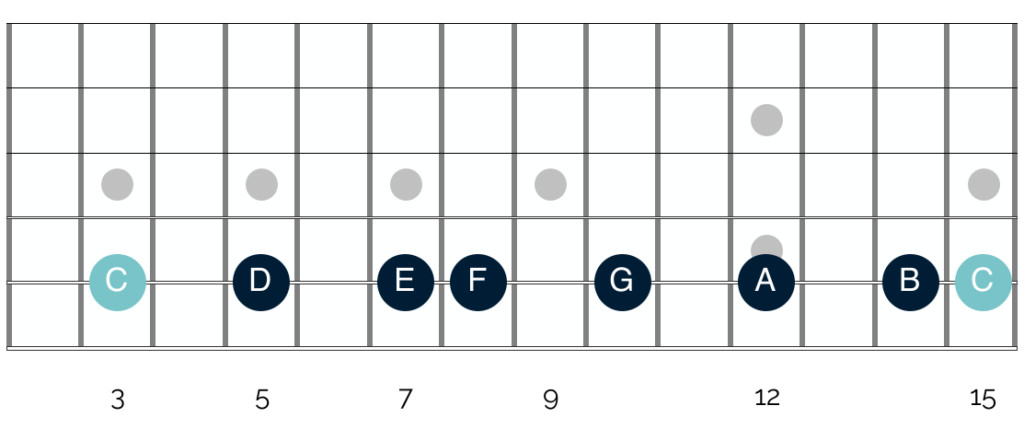 Understanding the major scale is the first step to understanding guitar chord theory
Understanding the major scale is the first step to understanding guitar chord theory
Alt Text: C Major Scale on Guitar Fretboard Diagram, illustrating the foundation for basic guitar chords.
In music theory, a chord is defined as a combination of at least three notes played simultaneously. Therefore, to create a chord from the major scale, we need to select and combine at least three notes from within that scale.
However, chord construction isn’t arbitrary. There’s a logical system that dictates which notes are combined and how. Understanding this logic, although initially challenging, is key to mastering guitar chords basic theory and will make learning and using chords far easier in the long run.
Creating Triads: The Simplest Chords
The specific notes you choose to combine, the number of notes, and their arrangement determine the type of chord you create. While there are many ways to alter these elements, let’s begin with the simplest chord structure: the triad.
As the name suggests (from the Latin “trias”), a triad is a chord composed of three notes. Specifically, these three notes are stacked in intervals of a “third.” This refers to the musical interval of a third.
If you’re new to intervals, or if you’re not completely confident with them, it’s beneficial to explore resources that explain musical intervals in detail before proceeding. Understanding intervals is crucial for grasping guitar chords basic theory.
For now, let’s revisit the C major scale:
| Note name | C | D | E | F | G | A | B |
|---|---|---|---|---|---|---|---|
| Scale degree | 1 | 2 | 3 | 4 | 5 | 6 | 7 |
The notes highlighted in yellow in the table above are the notes that form a C major triad. As mentioned, a triad consists of three notes, each separated by an interval of a third.
The term “third” might initially be confusing. Looking at the notes C and E, they seem to be separated by only one note, D, not three. The same applies to the distance between E and G.
The key to understanding “thirds” in this context is to remember that when counting intervals within a scale, you always include the starting note in your count.
Let’s take the C major scale example again. C is the first note, D is the second, and therefore, E is the third note from C. Similarly, to find a note a third above E, we count E as the first, F as the second, and G as the third.
Another way to visualize this is to think of “skipping” every other note in the scale. Starting on C, skip D and play E, then skip F and play G, and so on.
That’s the fundamental process of triad formation. Select three notes from the major scale, each a third apart. Play them together, and you have a triad – a basic guitar chord!

Intervals: The Key to Chord Quality
Now, things get a little more nuanced depending on which note of the major scale you begin with.
In the previous example, starting on C and building a triad resulted in a C major triad. However, this isn’t the case if you start on a different note within the scale.
This difference arises because of intervals. While a triad is defined by three notes stacked in thirds, the specific quality of those “thirds” – the intervals between the notes – determines the overall character of the chord.
If you’re familiar with the major scale, you’ll know that the distances, or intervals, between the notes are not all uniform. This is visually apparent when you look at the scale spread out across the guitar fretboard:
 Understanding the major scale is the first step to understanding guitar chord theory
Understanding the major scale is the first step to understanding guitar chord theory
Alt Text: Understanding the major scale is the first step to understanding guitar chord theory.
As you can see, some notes are separated by two frets, while others are separated by only one. This variation in fret distance, representing different intervals, becomes crucial when building triads from different starting notes within the scale.
Even though the notes in any triad are a “third” apart in scale degrees, the actual musical intervals between them change based on the starting note. Let’s compare a triad built on C with one built on D to illustrate this:
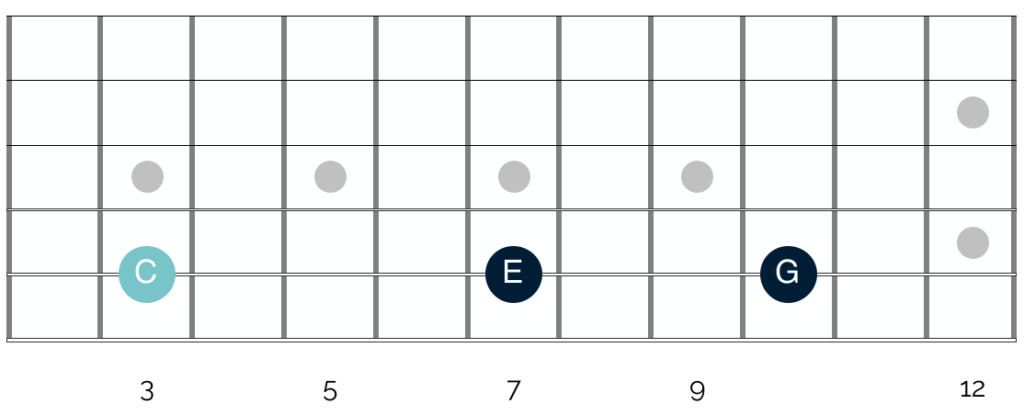 C major triad interval diagram
C major triad interval diagram
Alt Text: C Major Triad Diagram showing the intervals of Root, Major Third, and Perfect Fifth, essential for understanding basic guitar chords.
In this diagram, the starting note (root note) of the triad is C, highlighted in light blue. Notice that there are four frets between C and E and three frets between E and G. Between C and G (the root and the top note of the triad), there are seven frets.
Each fret on the guitar represents a semitone. So, in terms of whole tones and semitones:
- C to E: 4 frets = 2 whole tones
- E to G: 3 frets = 1 and a half tones
- C to G: 7 frets = 3 and a half tones
Now, let’s compare these intervals to a triad built starting on D:
 D minor triad interval diagram
D minor triad interval diagram
Alt Text: D Minor Triad Diagram highlighting the intervals of Root, Minor Third, and Perfect Fifth, key components of basic guitar chords.
Unlike the C triad, the intervals in the D triad are different:
- D to F: 3 frets = 1 and a half tones
- F to A: 4 frets = 2 tones
- D to A: 7 frets = 3 and a half tones
Just like the C triad, the distance between the root (D) and the top note (A) is 7 frets.
When we play the notes of each of these triads simultaneously, we hear a distinct difference: the C triad sounds like a C major triad, while the D triad sounds like a D minor triad.
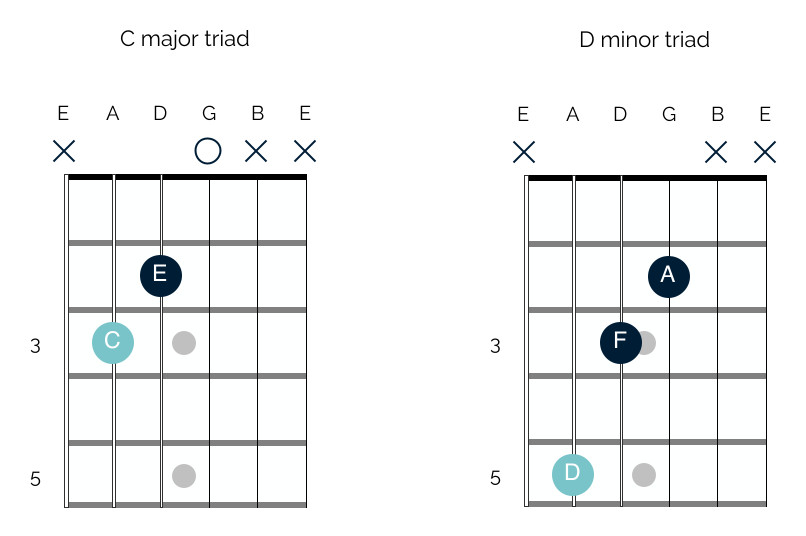 C major and D minor triads diagram
C major and D minor triads diagram
Alt Text: C Major and D Minor Triads Diagram, demonstrating the sound difference between major and minor basic guitar chords.
In the C major triad example shown here, open strings are utilized. Instead of fretting a G, the open G string is played.
It’s highly recommended to play both of these triads and listen carefully to their distinct sounds. Major triads generally have an upbeat, bright, and “happy” quality. In contrast, minor triads tend to sound more somber, melancholic, or “sad.”
This difference in sound between major and minor triads is a direct result of the different intervals between the notes within each triad. This is a fundamental concept in guitar chords basic theory, which we’ll explore further.
Major & Minor Triads: Unpacking the Intervals
As we’ve seen, building a triad starting on C in the key of C major produces a C major triad. Starting on D produces a D minor triad. Let’s examine the intervals within these triads to understand why.
Let’s look again at the fretboard diagrams, this time focusing on the intervals rather than just note names:
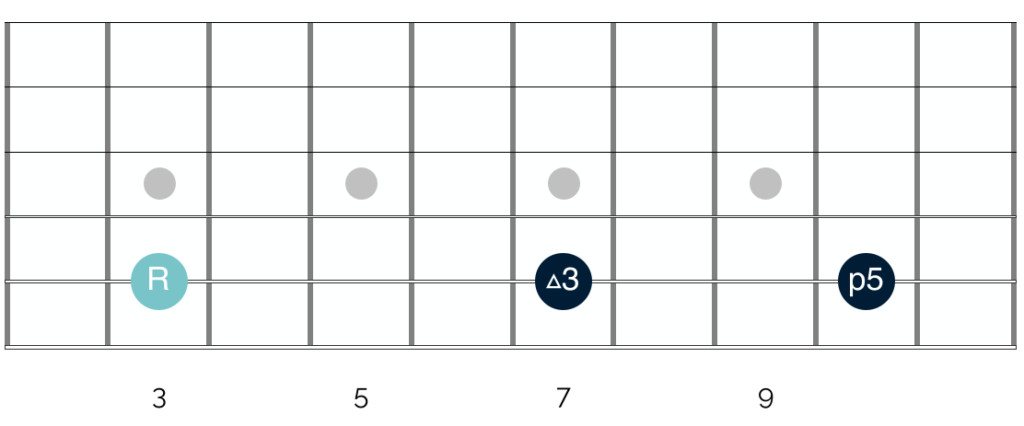 C major triad intervals diagram
C major triad intervals diagram
Alt Text: C Major Triad Intervals Diagram illustrating the Major Third and Perfect Fifth that define major basic guitar chords.
This diagram highlights the intervals within a C major triad:
- Root
- Major third
- Perfect fifth
The first note is always the root, which gives the chord its name (C in this case).
A major third is always four frets (or two whole tones) above the root. This “major” interval is what gives the chord its major quality.
A perfect fifth is always seven frets (or three and a half tones) above the root. Perfect intervals are associated with musical consonance and stability. The presence of the perfect fifth contributes to the harmonious and resolved sound of major chords.
Now, let’s compare these intervals to those in a D minor triad:
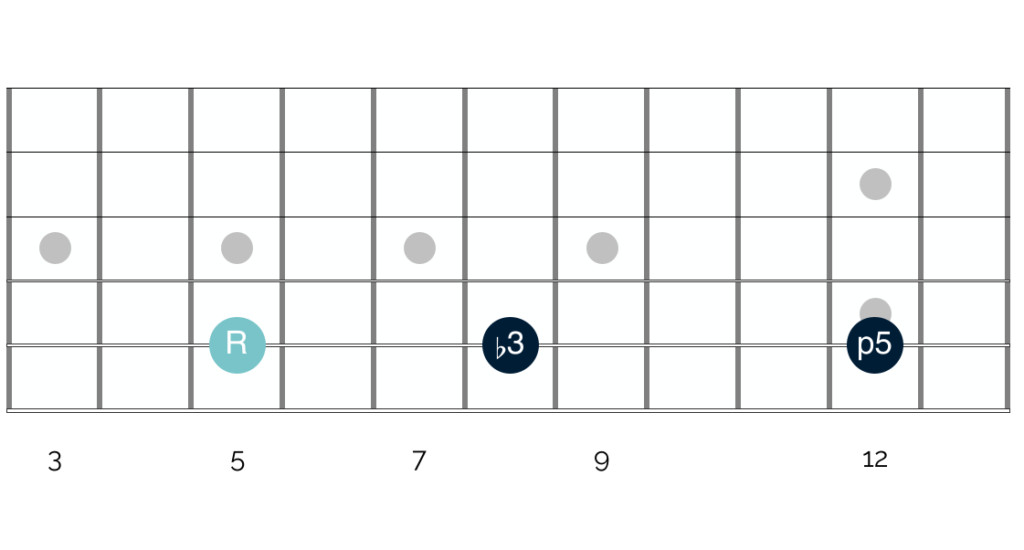 D minor triad intervals diagram
D minor triad intervals diagram
Alt Text: D Minor Triad Intervals Diagram showing the Minor Third and Perfect Fifth characteristic of minor basic guitar chords.
Here are the intervals within a D minor triad:
- Root
- Minor third
- Perfect fifth
Like the major triad, the minor triad has a root (D) and a perfect fifth. The key difference is the interval between the root and the second note: instead of a major third, it’s a minor third.
A minor third is always three frets (or one and a half tones) above the root – one fret lower than a major third. This “minor” interval is what gives the chord its minor quality, creating that slightly sad or melancholic sound.
Importantly, both major and minor triads contain a perfect fifth, contributing to their sense of stability and resolution, even though minor chords have a more somber tone. Neither major nor minor triads sound dissonant or tense.
Harmonizing the Major Scale: Unveiling Chord Families
To deepen our understanding of guitar chords basic theory, let’s apply the triad-building concept to every note within the major scale. This process, called “harmonizing the major scale,” reveals the inherent relationship between the notes of the scale and the types of triads they naturally form.
Let’s return to the C major scale notes and degrees:
| Note name | C | D | E | F | G | A | B |
|---|---|---|---|---|---|---|---|
| Scale degree | 1 | 2 | 3 | 4 | 5 | 6 | 7 |
Starting with C, we build a triad by selecting every other note (C, E, G). Then, we repeat this process starting on D (D, F, A), then E (E, G, B), and so on for each note of the scale.
When you reach the 7th note (B), continue the pattern by cycling back to the beginning of the scale to complete the triad. For example, starting on F, the triad notes are F, A, and C. For G, they are G, B, and D.
As you perform this exercise, keep these interval rules in mind:
- Major Third: 4 frets above the root. A triad containing a major third is a major triad.
- Minor Third: 3 frets above the root. A triad containing a minor third (and a perfect fifth) is a minor triad.
- Perfect Fifth: 7 frets above the root.
If you go through this process for all seven notes of the major scale, you’ll discover two key things. First, harmonizing the major scale produces a combination of both major and minor triads. Second, the triad built on the 7th degree of the scale has a different character compared to the major and minor triads.
Let’s see the results of harmonizing the C major scale:
| Note name | C | D | E | F | G | A | B |
|---|---|---|---|---|---|---|---|
| Notes in triad | C E G | D F A | E G B | F A C | G B D | A C E | B D F |
| Type of triad | Major | Minor | Minor | Major | Major | Minor | Diminished |
As you can see, harmonizing the major scale results in a specific pattern: three major triads, three minor triads, and one diminished triad.
This pattern is consistent across all major scales, regardless of the key. Whether you harmonize A major, B major, or D major, the order of major, minor, and diminished triads will remain the same. The specific notes within each triad will change to correspond to the notes of the respective major scale, but the types of triads will follow the major-minor-minor-major-major-minor-diminished sequence.
This pattern is incredibly significant because musicians use these chord families to create chord progressions. We’ll explore this further shortly. But first, let’s examine the diminished triad, which appears on the 7th degree of the major scale, in more detail.
Diminished Triads: Adding Tension
As you may have noticed when harmonizing the major scale, the triad built on the 7th scale degree has a different label: “diminished.” Let’s investigate why.
Looking at the notes of a B diminished triad on the fretboard reveals no obvious visual difference in their arrangement compared to major or minor triads:
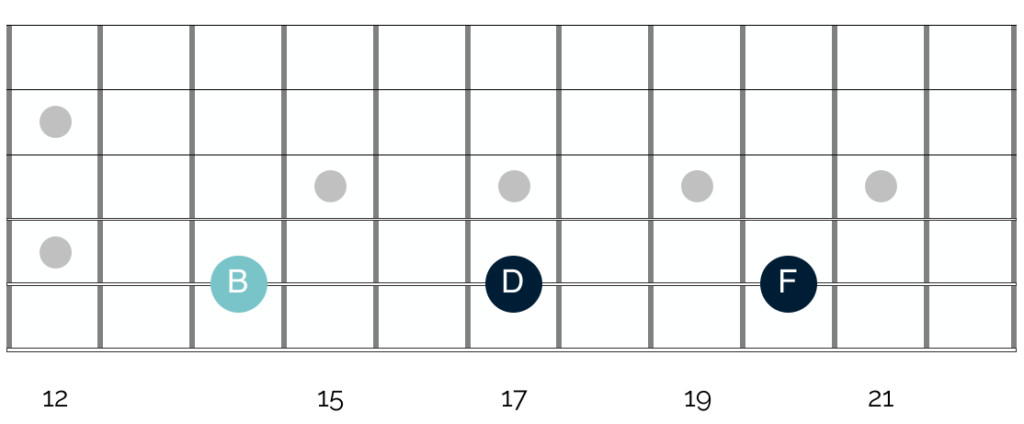 Diminished triads diagram
Diminished triads diagram
Alt Text: Diminished Triad Diagram showing the intervals, a less common but important basic guitar chord type.
The triad is still composed of three notes, seemingly stacked in thirds. So, what makes it “diminished” instead of major or minor?
The answer lies in the intervals between the notes:
 Diminished triads intervals diagram
Diminished triads intervals diagram
Alt Text: Diminished Triad Intervals Diagram highlighting the Minor Third and Flat Fifth intervals that create the dissonant sound of diminished basic guitar chords.
The intervals within a diminished triad are:
- Root
- Minor third
- Flat fifth
The root and minor third are the same as in a minor triad – three frets apart. The crucial difference is the interval that would typically be a perfect fifth. In a diminished triad, it’s a flat fifth.
A flat fifth is only six frets above the root, one fret less than a perfect fifth. This diminished interval creates a tense, dissonant, and unresolved sound, unlike the stable and consonant sounds of major and minor triads.
Because of their dissonant nature, diminished chords are less frequently used than major and minor chords. However, they are still important in music, adding color and tension to chord progressions. You’re less likely to build entire songs solely around diminished chords compared to major or minor chords, but they play a vital role in creating harmonic interest.

Triads & Chords: From Theory to Practice
At this point, you might be wondering how to apply this theoretical knowledge of triads to actual guitar playing. Understanding triads and their construction is valuable, but bridging the gap to practical application is essential for mastering guitar chords basic.
The term “triad” is more common in music theory discussions, while “chord” is the term guitarists use more frequently, especially beginners and intermediate players. Many guitarists might not even be familiar with the term “triad,” even though they are playing chords built from triads all the time.
To clarify the relationship and application, let’s define a triad in relation to a “chord” in a practical guitar context: A triad is a type of chord. Specifically, all triads are chords, but not all chords are triads. A triad is simply a chord with only three unique notes.
However, in practice, you don’t need to limit yourself to only playing three strings or frets to play a chord based on a triad.
Let’s revisit the C major triad diagram we saw earlier:
 C major triad shape diagram
C major triad shape diagram
Alt Text: C Major Triad Shape, a fundamental form for understanding basic guitar chords.
This diagram shows a C major triad using only three notes. If you’re new to chord theory, this specific triad shape might not be one you commonly use in your playing.
In contrast, you’re likely much more familiar with this C major chord shape:
 C major chord shape diagram
C major chord shape diagram
Alt Text: Common C Major Chord Shape, an expanded form of the basic C Major Triad on guitar.
This diagram shows a standard C major chord. It might seem misleading to call the first diagram a “C major triad” and the second a “C major chord,” but in reality, the terms are often used interchangeably. Both shapes represent the same fundamental chord: C major.
Both shapes contain the same three unique notes: C, E, and G. The “C major triad” shape explicitly shows these three notes. The common “C major chord” shape, when played in the open position, also contains only these three notes, but some are repeated at different octaves. Specifically, it plays C, E, G, C, and E.
It’s still considered a C major triad because it only contains three unique notes. This principle applies to most common major and minor chords you’re likely to learn as a beginner. They are often expanded versions of triads, with some notes repeated for fullness and playability on the guitar.
Consider the G major chord. The notes in a G major triad are G, B, and D. Here’s a triad shape for G major:
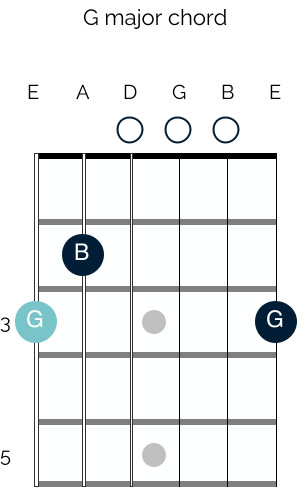 G major chord shape diagram
G major chord shape diagram
Alt Text: G Major Chord Shape, illustrating how basic guitar chords are built from triads.
This triad shape plays the core G, B, and D notes. The open D string provides the D note, and the other two notes are fretted.
When you play a full G major chord, you typically strum all six strings. However, if you analyze the notes in a standard G major chord shape, you’ll find they are still based on the G major triad: you play open G and B strings, and then another G note on the high E string. The other notes in the full G chord shape are also either G, B, or D, just in different octaves.
Creating Basic Chord Progressions
Understanding that common guitar chords are rooted in triads is a crucial step in connecting theory to practice. It allows you to see familiar chords in a new light and use this knowledge to create chord progressions.
Let’s revisit the table showing the triads derived from harmonizing the major scale:
| Note name | C | D | E | F | G | A | B |
|---|---|---|---|---|---|---|---|
| Notes in triad | C E G | D F A | E G B | F A C | G B D | A C E | B D F |
| Type of triad | Major | Minor | Minor | Major | Major | Minor | Diminished |
| Chord | C Major | D Minor | E Minor | F Major | G Major | A Minor | B Diminished |
| Triad / chord number | I | ii | iii | IV | V | vi | vii° |
In this table, we’ve added a row assigning Roman numerals to each triad. Just as scale degrees are numbered, so are the triads derived from harmonizing them. Roman numerals are used to represent chord numbers. Uppercase numerals denote major triads, and lowercase numerals denote minor triads. The diminished chord is also represented by a lowercase numeral, often with a small “°” symbol to indicate its diminished quality.
Musicians use these chords, in this specific order, to build chord progressions. Songs in the key of C major, for example, will often draw chords from this family.
The Beatles’ “Let It Be” provides a classic example. It’s in the key of C major, and its verse progression uses the chords: C major, G major, A minor, F major. In Roman numeral notation, this is I, V, vi, IV.
Guitarists and musicians frequently use Roman numerals to discuss chord progressions. If you hear musicians refer to a “one, four, five” progression, they are referring to the I-IV-V chords within a key. They are describing the type of triad or chord they are playing, relative to the key.
So, if you’re at a jam session and someone says, “Let’s play a I-IV-V in the key of C,” you instantly know the chord progression is C major, F major, and G major. Understanding guitar chords basic theory and Roman numeral notation unlocks a powerful way to communicate and understand music.
Beyond Basic Guitar Chord Theory
Chord progressions in real music are not always as straightforward as sticking strictly to chords from a single major scale. There are complexities that expand beyond these guitar chords basic principles.
Firstly, musicians often don’t limit themselves to chords solely within one major scale. While a song might be primarily based in a specific key, songwriters frequently incorporate key changes or “borrow” chords from other keys to add harmonic variation and interest.
Therefore, while understanding the chords derived from harmonizing the major scale is a significant step in guitar chords basic theory, there are further theoretical concepts to explore to fully analyze and understand the creation of diverse songs. These more advanced topics are beyond the scope of this introductory article, but will be explored in future discussions. For now, it’s important to be aware that chord progressions can be more intricate than the simple examples presented here.
Secondly, guitarists often go beyond basic major and minor chords by adding “chord extensions” to the fundamental triads. These extensions, such as 7th, 9th, or 13th intervals, don’t fundamentally alter the major or minor quality of the chord, but they enrich its sound and create more complex harmonies.
These extended chords are prevalent in popular music. You’ve likely encountered them in the form of major 7th, minor 7th, and dominant 7th chords. Like chord progressions, chord extensions are a deeper topic requiring further dedicated explanation.
The good news is that the guitar chords basic theory we’ve covered here provides a solid foundation for understanding chord extensions. Once you grasp the structure of triads and their intervals, understanding how extensions are added becomes much more accessible.
For now, focus on mastering the guitar chords basic theory outlined in this guide. This material is foundational and requires careful study and application. Don’t be discouraged if it seems challenging initially. Revisit these concepts, apply them to your guitar playing as much as possible, and with time and practice, it will become clearer and more intuitive.
Good luck on your guitar journey! Feel free to reach out with any questions you may have. You can leave a comment or send an email. Your progress and understanding are important, and help is always available!
References & Images
Unsplash, Guitar Habits, Wikipedia, Hello Music Theory, Music Notes Now, Wikipedia, Puget Sound, Open Music Theory, Guitar Theory For Dummies, Modern Music Theory For Guitarists
